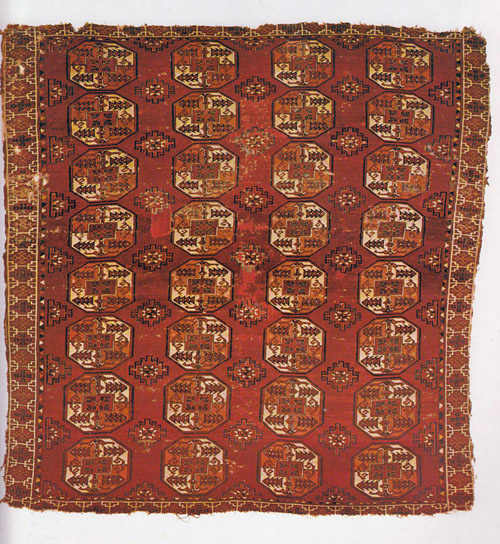Hi all,
Sorry to be getting these images
out on the late side. Meanwhile, the discussion may be passing them by,
but TurkoTek is a forgiving site.

The left hand of the following
images is from Loges, and he says that it is Saryk, not Ersari. He makes
the additional point that the Saryk were related to the Ersari of
Afghanistan. I'm not sure what to make of that, except it supports the
proposition that the distribution of these weaving designs and styles in
the region of Northern Afghanistan/Southern Turkmenistan is a complicated
business. The image on the right is from Tsareva,
Rugs and Carpets from
Central Asia, The Russian Collections (1984). She calls it Ersari,
placing it in the mid-nineteenth century and adding the comment that no
near analogies to it had been found. The two pieces together demonstrate
how different the statement made by the "same" gul can be.


The following pair
are called by Schurmann (left), "Beshir," and by Tsareva (right),
"Ersari," again emphasizing the identity crisis inherent in this group.
Eiland illustrates one of them and comments that "...it seems doubtful the
lozenge figures have any significance as guls." Perhaps not, but the use
of opposing colors in the quartered sections must have some relationship
to the same practice in the drawing of many guls.


The following example,
from Bausback, 1975, carries the "opposing quarter" concept (as adapted in
this type of Ersari/Beshir) even farther. Rugs of this general type, and
the two preceding, can be seen in late nineteenth and early twentieth
century photos of the region, as mentioned by James Blanchard.
Incidentally, the way the field here is divided into roughly square blocks
is suggestive of the same technique shown in an Afgahn rug from Loges I
posted on February 7. There, the dividing lines employed the
badam
border line. Perhaps the similarity is a coincidence.

This example,
also from Bausback, is included just to remind us that it isn't
necessarily always about guls.

Finally, one more from
Bausback. I include it to exemplify the highly regular, not to say boring
quality of the later-but-not-too-late Afghan Ersaris.

Perhaps it's a
little more bracing in person.
Rich
Larkin